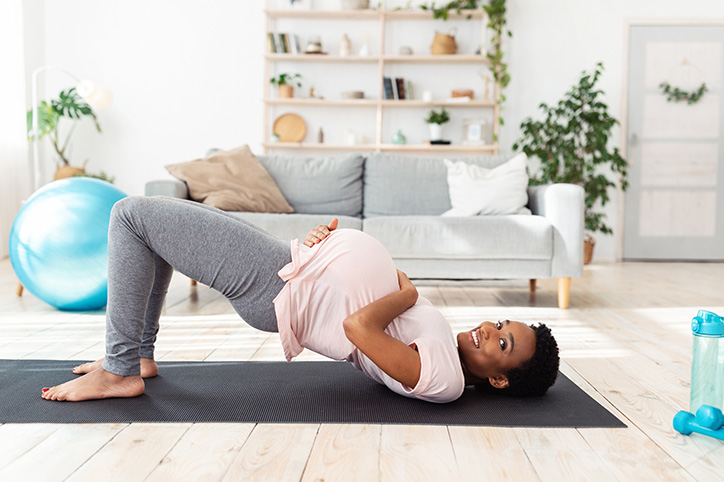Many women fear working out when they’re pregnant but, at this point, the research clearly shows that NOT exercising is actually riskier than exercising for women having normal pregnancies. “The benefits of pregnancy exercise for mom and baby are truly significant,” says Nancy Anderson, a certified fitness trainer, nutrition specialist and pre- and post-natal expert. “So, ideally we want to get moms moving throughout every trimester, always with their doctor’s approval, of course. For the vast majority of women, this means doing 30-60 minutes of moderately intense aerobic exercise as well as resistance training, most days of the week.” And that includes working your abs while pregnant.
Just because an exercise works for your pregnant friend, doesn’t mean it will work for you.
Not everyone’s pre-natal workout program should be created equally. Some women have no problem running throughout their pregnancy yet can’t muster up the energy to do a squat. For others the idea of even speed walking is nausea-inducing. Others will have no problem jumping rope, while their pregnant friend can’t even do a round of jumping jacks without feeling off. It’s incredibly important to listen to your body and do what feels good when you’re pregnant. That said, many women are surprised to learn that you can work your abs while pregnant and many regular ab moves can be safe – and very beneficial – throughout pregnancy. “It’s important to remember that proper core engagement when doing ab moves is key – any exercise can be made ‘safe’ or ‘unsafe’ as it relates to Mom’s body during pregnancy. Proper engagement, breathing strategies and motor skills are needed to optimize any exercise.”
Even crunches and sit-ups are OK when pregnant?
“When many hear ‘abs’ they think crunches/sit-ups, so let’s cover that,” says Anderson. “Honestly, anything that has forward flexion is going to offer more risk than reward to almost all women later in pregnancy. Outward and/or downward pressure on the line alba and pelvic floor, which is common when forward flexion is performed, can increase the risk of pelvic floor dysfunction and diastasis recti and may make it harder for women to recover post pregnancy. The good news is that pretty much any other exercise or position is on the table for Mom and there really are no hard rules.”
“For some Moms laying on their back for ab exercises may not be comfortable, while other moms may not tolerate specific exercises, like planks, and they will need to modify and know what signs of intolerance to look for (for example, coning of the stomach),” says Anderson. While a common reason for cutting back on working out is a fear of postpartum ab separation Anderson notes that the research actually tells us that women who exercise throughout their pregnancy are less likely to have significant ab separation. Once again, it’s important to remember that how you’re doing an exercise is just as important, if not more so, than what the actual exercise is. So yes, working your abs while pregnant is safe and even recommended.
Form is everything.
“Working on your abs while pregnant and learning how to properly engage the core is really important, but it needs to be included in the broader context of whole body movement. It does not start or finish with planks, crunches or any specific exercise. It’s takes a multi-fasciated approach to have an optimally functioning core during and post pregnancy and to avoid things like diastasis,” says Anderson. “It’s important to maintain core awareness and proper engagement during every exercise a mom does including squats, deadlifts, ring rows, etc., as well as during any moderately intense aerobic activities.” Apps like Move Your Bump and programs like Every Mother can be incredibly helpful for developing a safe and effective pre- and post-natal fitness program.
What about post-baby?
It’s totally valid to want your abs back after pregnancy and to feel better about the way you look. ” Getting your abs back isn’t even just about aesthetics; postpartum core dysfunction is also related to things like back pain, pain during sex, urinary incontinence and more,” says Anderson. “I think all moms would do well to be purposeful about their core recovery—whether it’s one month, one year or one decade postpartum.
Here are some of Anderson’s favorite postpartum abs tips:
- “Follow a training program like my 12 Week Post Pregnancy Ab Rehab Course (with Coaching) that will teach you how to rehabilitate your core unit, close your diastasis, restore rib alignment and so on. Our coaches work directly with clients through private video and text chats to customize the course to each clients specific needs.”
- “Once you understand the basics of proper core engagement, use it throughout your daily life. Pay attention to your posture as you’re doing things like sitting, breastfeeding or picking up a car seat or a pair of dumbbells. With enough practice, you won’t have to consciously think about.”
- “Practice breath work. The breath/nervous system/core connection has huge potential that goes untapped in a lot of us. In the rehab part of your post pregnancy journey this is a very important, but often skipped step. I’ve healed clients diastasis which only fixing just their breath.”
- “When in doubt, consult with a professional. Healing the body post pregnancy truly requires a multi-faceted approach. There is no one exercise that will close your diastasis or fix your pelvic floor dysfunction. Kegals are not the answer, and closing the gap isn’t the goal. Instead the goal needs to be to fix the root of the dysfunction that causes the leaking or diastasis. This requires a customized approach that covers: posture, alignment, breathing, motor skills, activation/recruitment patterns and strength. This can be overwhelming to try to figure out on your own, so this is a great time to invest in working with experts who can help support, guide, coach and supply you with the tools to actually heal long term.”
Tell us, did you work your abs while pregnant?
